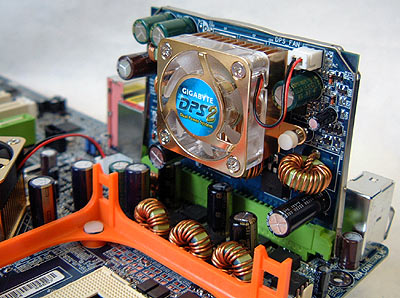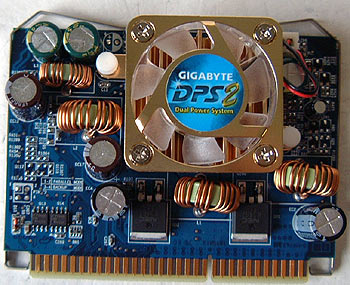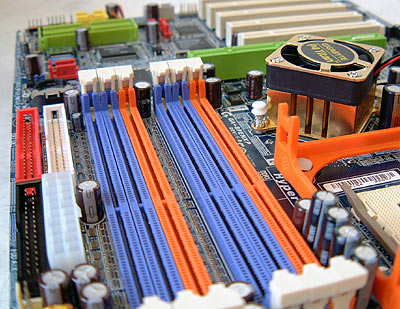
|
Standard features of the board consist of Serial ATA/Serial ATA RAID, Ultra
133 IDE RAID, IEEE 1394, 5.1 audio, Intel CSA enabled Gigabit LAN, dual
BIOS's and Gigabyte's special DPS2.
87% Rating: 
|
|
|
|
Home >
Reviews >
Motherboards >
Gigabyte GA-8PENXP |
|
|
More on the 8PENXP
While almost all i865PE/i875P based motherboards have
Gigabit LAN, we're happy to see that Gigabyte chose to use the Intel
CSA
enabled 82547EI NIC. Because
the board supports a whole host of high bandwidth devices (USB 2.0, IEEE 1394,
Serial ATA RAID, etc) the PCI bus can be saturated very quickly. With the CSA
Intel NIC, you're not going to make a potentially bad situation worse.
Intel officially stated that the current batch of
i865PE/i875P based motherboards do not support the upcoming
Socket 478 Prescott processor (typical...) because of voltage regulations and
differences, however there are rumors out there that the Gigabyte 8PENXP in fact
does support the chip thanks to its Dual Power
System.
 
Of course whether the board or not will
indeed be compatible with the Prescott will not be known until the processor is
released later in 2003.
Officially the DPS2 should relay 'cleaner' power to the processor which should
lead to better stability (it is 6 phase instead of 3 phase).
Our particular motherboard worked just fine without the unit plugged in, even
when overclocked.
Gigabyte's 8PENXP is the only i865PE
motherboard on the market to have six DIMM slots. Unfortunately
because the i865PE can only support up to a maximum of eight banks of memory
(each side of a DIMM is one bank), if you're using double sided memory you can
only use four of the memory slots. Potentially though, if you're using single
sided DIMM's you should be able to fill all the slots.

The only complaint I have about the motherboard is that
there is no clear CMOS jumper. Instead, users must short two solder
points on the
motherboard if they wish to reset the CMOS.
If you're interested in learning a bit
more on i865PE aka Springdale architecture, please read our AOpen AX4SPE Max review. Up next, we tackle the gentlemen's
game of overclocking...
|
